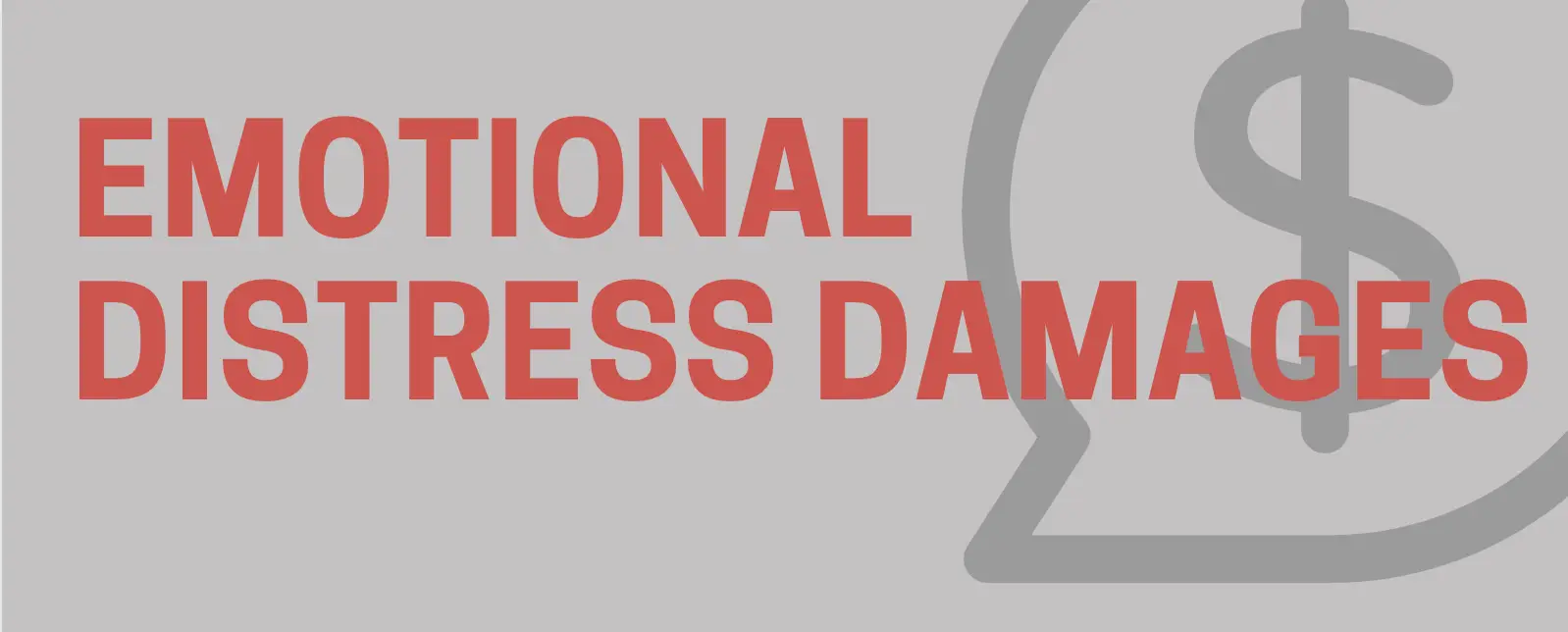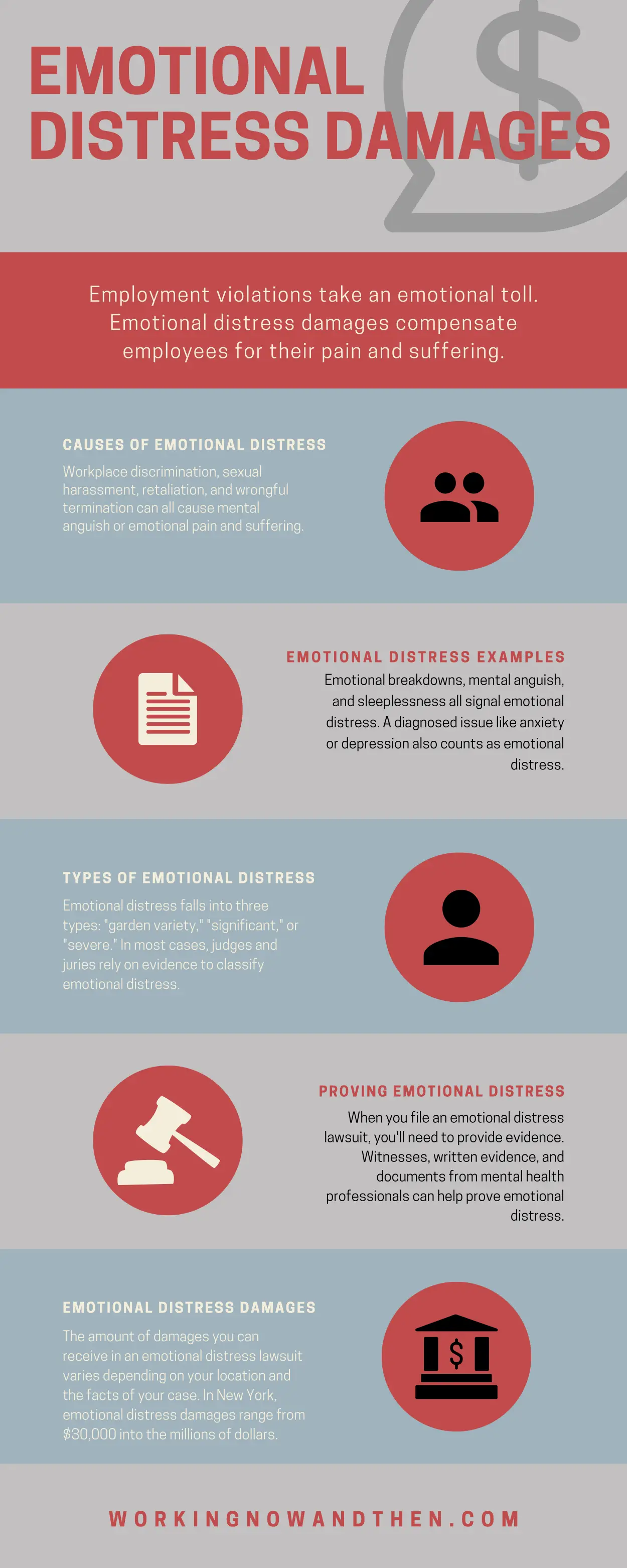
A Guide To Suing For Emotional Distress
January 20, 2022
By Charles E. Joseph
Workplace discrimination, sexual harassment, and retaliation take an emotional toll. If you’ve experienced mistreatment at work, you’ve probably wondered, “Can I sue my employer for emotional distress?”
Fortunately, victims of employment violations can sue for emotional distress damages. In this article, we’ll explain the process of suing for emotional distress and how to file an emotional distress lawsuit.
Suing for Emotional Distress
What is emotional distress? And can you sue for emotional distress?
Emotional distress is the mental anguish employees experience as a result of workplace discrimination, harassment, or a hostile work environment. Lawsuits for wrongful termination, retaliation, and sexual harassment often award emotional distress damages.
These damages compensate employees for the emotional pain caused by harassment, discrimination, or job loss.
The traumatic effects of problems at work and job loss can be as powerful as losing a permanent relationship or learning of a terminal illness, according to industrial psychologists.
As a result, emotional distress damages should not be viewed as a sign of weakness or ignored.
In an emotional distress lawsuit, the jury decides how much damages to award the employee. It’s not unusual for juries to award millions in emotional distress damages.
However, jurors do not determine the final amount the plaintiff receives. Judges can (and do) lower emotional distress damages, sometimes dramatically.
Damages in Employment Law Cases
Employment lawsuits award damages in several forms. Where do emotional distress damages fit in?
Victims of wrongful termination can receive back pay. These damages pay what the employee would have earned without being terminated. Terminated employees can also receive front pay to cover future lost earnings.
Courts can also award punitive damages. These punish employers for violating laws against discrimination, sexual harassment, and other employment violations.
In many employment lawsuits, emotional distress damages make up the majority of money damages.
Types of Emotional Distress Damages
Emotional distress damages come in several forms. While courts don’t use a set standard, they generally classify the damages in a few common categories: garden variety, significant, and egregious.
In many cases, the strength of the victim’s evidence determines the emotional distress damages.
Garden Variety Emotional Distress Damages
A garden variety emotional distress claim rests on the victim’s testimony without significant supporting evidence.
As one law described it, a plaintiff with a garden variety claims “describes his or her injury in vague or conclusory terms, without relating either the severity or consequences of the injury.”
New York courts generally award $30,000 to $125,000 for garden variety claims.
With supporting evidence, a garden variety claim can move into the significant emotional distress category.
Significant Emotional Distress Damages
Employment lawsuits with significant emotional distress generally see higher damages than garden variety emotional distress.
However, unlike garden variety emotional distress, courts expect more evidence to find significant emotional distress. This can include proof that the victim sought help from their doctor or visited a therapist or counselor. Corroborating evidence from witnesses can also prove significant emotional distress.
In New York, awards for significant emotional distress damages range from $50,000-$200,000.
Egregious Emotional Distress Damages
Most courts classify egregious emotional distress as cases with “outrageous or shocking conduct.” This category also includes employment violations that had a significant impact on the victim’s physical health.
Victims can receive $200,000 or more in damages for egregious emotional distress.
Emotional Distress Examples
Emotional pain and suffering can take several forms. When evaluating an emotional distress lawsuit, courts look for evidence of mental anguish, emotional trauma, or a newly diagnosed mental health disorder.
Examples of emotional distress include:
- A diagnosed mental health disorder like anxiety or depression
- Damage to the employee’s reputation
- Emotional breakdowns or other emotional trauma
- Mental anguish
- Sleeplessness or nightmares
Counselors or therapists can testify about emotional harm or mental health disorders. Victims and their coworkers or family members can testify about breakdowns, sleeplessness, or other forms of mental anguish. The next section walks through how to prove emotional distress.
In employment lawsuits, certain types of cases typically award damages for emotional pain and suffering.
Cases that often award emotional distress damages include:
For example, a judge upheld an award of nearly $500,000 for a case where the “plaintiff’s career was ruined because defendant spread rumors that plaintiff was a ‘gay child molester’ and plaintiff became suicidal for years.”
In a racial discrimination case, the victim received $1.3 million after several years of harassment from coworkers. The extreme harassment caused “post-traumatic stress disorder, short-term adjustment disorder, depression, a panic disorder, and multiple hospitalizations.”
In a disability discrimination case, the victim received $600,000 after the court heard evidence of serious emotional trauma and breakdowns.
How To Prove Emotional Distress
Judges and juries look for specific evidence to award emotional distress damages. But what counts as strong evidence?
The employee can testify about the emotional harm caused by discrimination, harassment, or retaliation. Similarly, coworkers, family members, or friends can act as witnesses to describe how the employment violation affected the plaintiff.
Providing letters, emails, texts, and other written proof of emotional pain and suffering will help strengthen the testimony.
Documents from a mental health professional can also help prove emotional distress. If the victim went to a therapist or counselor to talk about what happened, these records can help prove their case.
Sometimes victims of employment violations experience depression or anxiety. Evidence that a mental health professional diagnosed the victim with a mental health disorder can increase the damages in an emotional distress lawsuit. Similarly, a professional prescribing medication to manage emotional harm can help prove emotional pain and suffering.
Finally, in serious cases, testimony from a doctor about physical harm can strengthen an emotional distress lawsuit.
In addition to the evidence provided by the plaintiff, courts also look at the severity and duration of the employment violation. Long-term or more severe harassment can translate into a higher award.
Want to know more? Check out our FAQ on Suing for Emotional Distress
What To Consider Before Suing for Emotional Distress
During an employment lawsuit, juries award damages for emotional pain and suffering. However, the judge can reduce “excessive” awards. For example, in a 2014 case, a Manhattan judge reduced the emotional distress damages from $250,000 to $80,000. The judge argued that the plaintiff did not provide enough evidence of lasting emotional impact.
In a 2008 case, another judge reduced an award from $125,000 to $25,000 because the trial did not include medical testimony.
These examples offer guidance to people considering an emotional distress lawsuit. More evidence typically translates into a higher damages award. New York courts often uphold awards of more than $200,000 when mental health experts testify about the victim’s emotional trauma and mental anguish.
If you experience emotional distress because of an employment violation, you can take concrete steps to improve your chances of damages.
First, consider discussing the situation with your doctor, especially if you experience sleeplessness, an increase in stress, or anxiety because of harassment, discrimination, or wrongful termination.
Second, start putting together documents that back up your emotional anguish. For example, emails or texts that speak to your emotional state and the reasons for it.
Third, make a list of people who can serve as witnesses. Coworkers who witnessed the employment violation, friends who supported you through job loss, and family members or a clergyperson who can testify about your mental state can all strengthen your case.
Finally, an emotional distress lawyer can help you prove emotional distress and increase your damages from a lawsuit. Plaintiffs need someone on their side who understands the law and will fight for their rights. Most employment cases settle out of court – an attorney can also make sure you receive a fair settlement.
Frequently Asked Questions about Emotional Distress
What is emotional distress?
Emotional distress means mental suffering like sadness, anxiety, anger, or other upsetting emotions. In a legal context, courts award damages for emotional distress. For example, if harassment or discrimination at work affected your mental health, you might receive emotional distress damages.
Can I sue my employer for emotional distress?
Yes, you can sue your employer for emotional distress. This is known as an emotional distress lawsuit. When suing for emotional distress, you will need to prove that your employer violated your rights and that it caused emotional harm. Discrimination, retaliation, wrongful termination, and harassment can all cause emotional distress. Contact an emotional distress lawyer to learn more.
How much can I sue for emotional distress?
The damages in an emotional distress lawsuit depend on the facts of the case and the strength of your evidence. New York courts typically award anything from $30,000 to $200,000 or higher in damages for emotional distress. For more on how to calculate damages for emotional distress, contact an emotional distress lawyer.
Have more questions? Check out our FAQ on Suing for Emotional Distress
Charles Joseph has over two decades of experience in employment law. He is the founding partner of Joseph and Kirschenbaum, a firm that has recovered over $140 million for clients, and the creator of Working Now and Then.
Contact Charles Joseph to find out if you have an emotional distress lawsuit.

